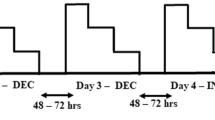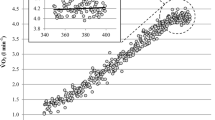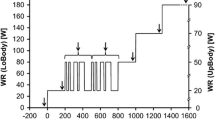Abstract
Recent research in which data were averaged over 10 or 30 s suggests that the V̇O2 response of aerobically fit individuals plateaus below V̇O2 max in an exhaustive square-wave run lasting ~2 min. To investigate this phenomenon we examined the breath-by-breath V̇O2 response of trained runners to an exhaustive treadmill run at 800 m pace. Eight male competitive runners completed two treadmill tests on separate days: a ramp test to exhaustion and an exhaustive square-wave run at 800-m pace. For the ramp test, the breath-by-breath data were smoothed with a 15-s moving average and the highest of the smoothed values was taken as V̇O2 peak [mean (SD): 68.9 (5.6) ml kg−1 min−1]. For the square-wave, the breath-by-breath data were interpolated to give one value per second and modelled using a monoexponential function. Following a delay of 11.2 (1.5) s, V̇O2 increased quickly [phase-2 time constant of 10.7 (2.7) s] towards an asymptote that represented just 85 (6)% of V̇O2 peak from the ramp test. Expressed in ml kg−1 min−1, this asymptote was independent of V̇O2 peak (r=0.04, P=0.94). However, as a percentage of V̇O2 peak it was negatively correlated with V̇O2 peak itself (r=−0.96, P<0.001). It is concluded that in an exhaustive square-wave treadmill run lasting ~2 min the V̇O2 of aerobically fit runners increases quickly to plateau at a level that is lower than, but independent of, V̇O2max



Similar content being viewed by others
References
Atkinson G, Nevill AM (1998) Statistical methods for assessing measurement error (reliability) in variables relevant to sports science. Sports Med 26:217–238
Barstow TJ, Lamarra N, Whipp BJ (1990) Modulation of muscle and pulmonary oxygen uptakes by circulatory dynamics. J Appl Physiol 68:979–989
Barstow TJ, Jones AJ, Nguyen PH, Casaburi R (1996) Influence of muscle fibre type and pedal frequency on oxygen uptake kinetics of heavy exercise. J Appl Physiol 81:1642–1650
Beaver WL, Lamarra N, Wasserman K (1981) Breath-by-breath measurement of true alveolar gas exchange. J Appl Physiol 51:1662–1675
Beaver WL, Wasserman K, Whipp BJ (1986) A new method for detecting anaerobic threshold by gas exchange. J Appl Physiol 60:2020–2027
Capelli C (1999) Physiological determinants of best performances in human locomotion. Eur J Appl Physiol 80:298–307
Carter H, Jones AW, Barstow TJ, Burnley M, Williams CA, Doust JH (2000) Oxygen uptake kinetics in treadmill running and cycle ergometry: a comparison. J Appl Physiol 89:899–907
Carter H, Pringle JSM, Jones AM, Doust JH (2002) Oxygen uptake kinetics during treadmill running across exercise intensity domains. Eur J Appl Physiol 86:347–354
Cautero M, Beltrami AP, Prampero di PE, Capelli C (2002) Breath-by-breath alveolar oxygen transfer at the onset of step exercise in humans: methodological implications. Eur J Appl Physiol 88:203–213
Draper SB, Wood DM and Fallowfield JL (2003) The V̇O2 response to exhaustive square-wave exercise: influence of exercise intensity and mode. Eur J Appl Physiol 90:92–99
Efron B, Tibshirani R (1993) An introduction to the bootstrap. Chapman and Hall, London
Farhi LE (1964) Gas stores of the body. In: Fenn WO, Rahn H (eds) Handbook of physiology, sect 3: Respiration, vol 1. American Physiological Society, Washington, pp 873–885
Gaesser GA, Poole DC (1996) The slow component of oxygen uptake in humans. Exerc Sport Sci Rev 24:35–70
Gerbino A, Ward SA, Whipp BJ (1996) Effects of prior exercise on pulmonary gas-exchange kinetics during high-intensity exercise in humans. J Appl Physiol 80:99–107
Hill DW (1999) Energy systems contributions in middle-distance running events. J Sports Sci 17:477–483
Hill DW, Ferguson CS (1999) A physiological description of critical velocity. Eur J Appl Physiol 79:290–293
Hill DW, Stevens EC (2001) The V̇O2 response at the onset of severe intensity exercise. Can J Appl Physiol 26:350–355
Hill DW, Halcomb JN, Stevens EC (2003) Oxygen uptake kinetics during severe intensity running and cycling. Eur J Appl Physiol 89:612–618
Hughson RL, O’Leary DD, Betik AC, Hebestreit H (2000) Kinetics of oxygen uptake at the onset of exercise near or above peak oxygen uptake. J Appl Physiol 88:1812–1819
Lamarra N, Whipp BJ, Ward SA, Wasserman K (1987) Effect of interbreath fluctuations on characterizing gas exchange kinetics. J Appl Physiol 62:2003–2012
Mettauer B, Zhao QM, Epailly E, Charloux A, Lampert E, Heitz-Naegelen B, Piquard F, Prampero PE di, Lonsdorfer J (2000) V̇O2 kinetics reveal a central limitation at the onset of subthreshold exercise in heart transplant recipients. J Appl Physiol 88:1228–1238
Motulsky HJ, Ransnas LA (1987) Fitting curves to data using nonlinear regression: a practical and nonmathematical review. FASEB J 1:365–374
Ozcelik O, Ward SA, Whipp BJ (1999) Effect of altered body CO2 stores on pulmonary gas exchange dynamics during incremental exercise in humans. Exp Physiol 84:999–1011
Peronnet F, Thibault G (1989) Mathematical analysis of running performance and world running records. J Appl Physiol 67:453–465
Poole DC, Richardson RS (1997) Determinants of oxygen uptake. Sports Med 24:308–320
Poole DC, Ward SA, Gardener GW, Whipp BJ (1988) Metabolic and respiratory profile of the upper limit for prolonged exercise in man. Ergonomics 31:1265–1279
Powers SK, Dodd S, Beadle RE (1985) Oxygen uptake kinetics in trained athletes differing in V̇O2 max. Eur J Appl Physiol 54:306–308
Prampero PE di (1981) Energetics of muscular exercise. Rev Physiol Biochem Pharmacol 89:141–222
Prampero PE di (1986) The energy cost of human locomotion on land and in water. Int J Sports Med 7:55–72
Prampero PE di, Capelli C, Pagliaro P, Antonutto G, Girardis M, Zamparo P, Soule RG (1993) Energetics of best performances in middle-distance running. J Appl Physiol 74:2318–2324
Pringle JSM, Carter H, Doust JH, Jones AM (2002) Oxygen uptake kinetics during horizontal and uphill treadmill running in humans. Eur J Appl Physiol 88:163–169
Pringle JSM, Doust JH, Carter H, Tolfrey K, Campbell IT, Jones AM (2003) Oxygen uptake kinetics during moderate, heavy and severe intensity exercise in humans: the influence of muscle fibre type and capillarisation. Eur J Appl Physiol 89:289–300
Rossiter HB, Ward SA, Doyle VL, Howe FA, Griffiths JR, Whipp BJ (1999) Inferences from pulmonary O2 uptake with respect to intramuscular [phosphocreatine] kinetics during moderate exercise in humans. J Physiol (Lond) 518:921–932
Spencer MR, Gastin PB (2001) Energy system contribution during 200- to 1500-m running in highly trained athletes. Med Sci Sports Exerc 33:157–162
Spencer MR, Gastin PB, Payne WR (1996) Energy system contribution during 400- to 1500-metres running. New Stud Athletics 11:59–65
Svedenhag J, Sjodin B (1984) Maximal and submaximal oxygen uptakes and blood lactate levels in elite male middle and long distance runners. Int J Sports Med 5:255–261
Swanson GD (1980) Breath-to-breath considerations for gas exchange kinetics. In: Cerretelli P, Whipp BJ (eds) Exercise bioenergetics and gas exchange. Elvesier, Amsterdam, pp 211–222
Whipp BJ (1994) The slow component of O2 uptake kinetics during heavy exercise. Med Sci Sports Exerc 26:1319–1326
Whipp BJ, Ozyener F (1998) The kinetics of exertional oxygen uptake: assumptions and inferences. Med Dello Sport 51:139–149
Wilkie DR (1980) Equations describing power input by humans as a function of duration of exercise. In: Cerretelli P, Whipp BJ (eds) Exercise bioenergetics and gas exchange. Elvesier/North-Holland, Amsterdam, pp 75–81
Xu F, Rhodes EC (1999) Oxygen uptake kinetics during exercise. Sports Med 27:313–327
Acknowledgements
This study was supported by a University College Chichester Research Studentship. These experiments comply with the current laws of the United Kingdom.
Author information
Authors and Affiliations
Corresponding author
Rights and permissions
About this article
Cite this article
Draper, S.B., Wood, D.M. The V̇O2 response for an exhaustive treadmill run at 800-m pace: a breath-by-breath analysis. Eur J Appl Physiol 93, 381–389 (2005). https://doi.org/10.1007/s00421-004-1278-z
Accepted:
Published:
Issue Date:
DOI: https://doi.org/10.1007/s00421-004-1278-z




